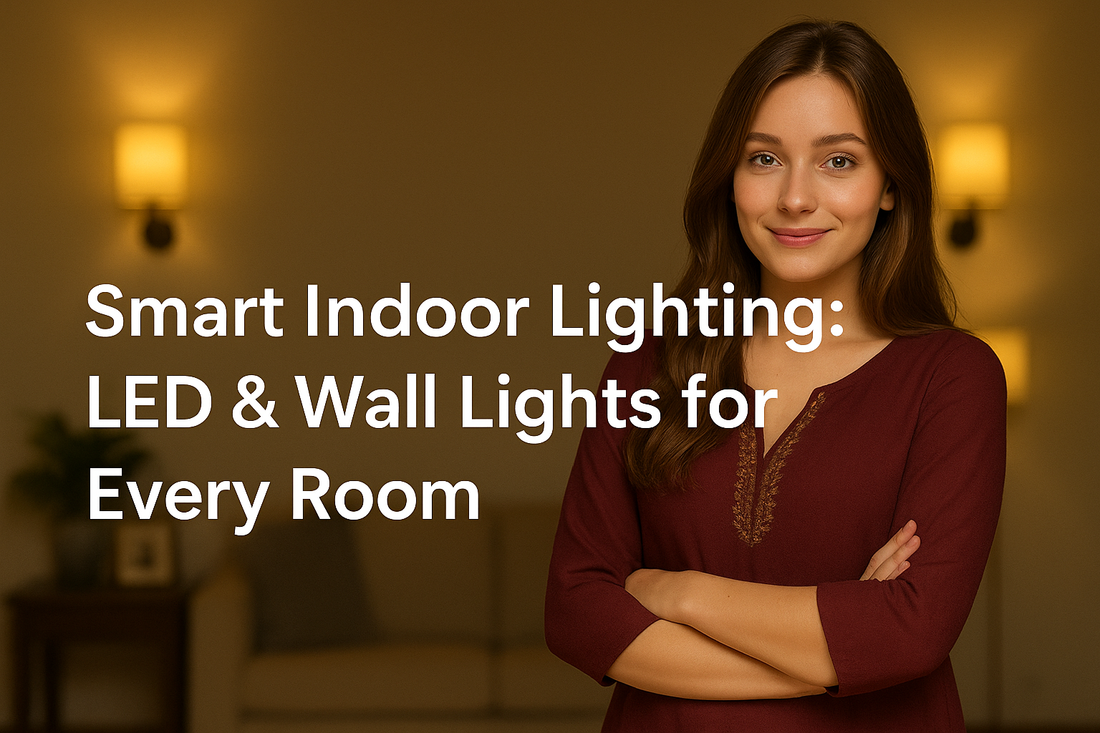
Smart Indoor Lighting: LED & Wall Lights for Every Room
Share
Lighting is one of the most powerful tools in interior design. It doesn’t just illuminate your space—it enhances mood, improves function, and transforms the way your home looks and feels. Among all lighting options, indoor LED lights for home and indoor wall lights stand out as energy-efficient, stylish, and versatile solutions.
In this complete guide, we’ll explore how to effectively use LED and wall lights to brighten and beautify every room in your home. Whether you’re upgrading your living room or renovating your bedroom, this blog covers everything from types and benefits to design tips and installation best practices.
Why Indoor Lighting Matters More Than You Think
Lighting influences more than just visibility. It affects how we experience space. Poor lighting can make a luxurious room feel cold or cramped, while great lighting can make a simple space feel elegant and functional.
Good Lighting:
-
Enhances mood and comfort
-
Boosts productivity
-
Improves safety
-
Increases property value
-
Supports energy savings
By combining indoor LED lights with smart placement of indoor wall lights, homeowners can achieve an ideal mix of style, efficiency, and function.
The Benefits of Indoor LED Lights for Home
LED (Light Emitting Diode) technology has revolutionized home lighting. Here's why LED lighting should be your go-to solution:
1. Energy Efficient
LEDs use up to 80% less electricity compared to traditional bulbs, lowering your monthly bills.
2. Long Lifespan
Most LED bulbs last 25,000–50,000 hours—several years with regular use.
3. Low Heat Emission
Unlike incandescent or halogen bulbs, LEDs stay cool, reducing the risk of burns or fire.
4. Eco-Friendly
LEDs are mercury-free and recyclable, contributing to a greener planet.
5. Available in Multiple Styles
From recessed ceiling lights to pendant LEDs and strip lighting, the design options are endless.
Popular Types of Indoor LED Lights for Home
When choosing indoor LED lights for home, consider these common categories:
● Recessed Lights (Downlights)
Perfect for general lighting in living rooms and kitchens, recessed lights are discreet yet powerful.
● LED Strip Lights
Ideal for under-cabinet lighting, backlighting TVs, or adding glow under furniture.
● Ceiling-Mounted LED Panels
Great for large rooms where even, bright light is needed.
● Pendant LED Lights
Suspended from the ceiling, they work well over dining tables, kitchen islands, or study desks.
● Cove Lighting
Hidden within ceiling recesses, it creates a luxurious, diffused lighting effect.
The Role of Indoor Wall Lights in Home Design
Indoor wall lights are mounted on walls and serve multiple functions—from ambient and task lighting to decorative purposes.
Why Choose Wall Lights?
-
Space Saving: They don’t take up floor or table space.
-
Versatile Use: Serve as both primary and supplementary light sources.
-
Decorative Appeal: Available in styles ranging from vintage to ultra-modern.
-
Layered Lighting: Help create depth by complementing ceiling lights.
Top Types of Indoor Wall Lights
Choosing the right wall light depends on your needs and room design:
● Wall Sconces
Classic and versatile. Great for hallways, living rooms, and bedrooms.
● Swing Arm Lamps
Adjustable and ideal for bedside reading or work nooks.
● Picture Lights
Used to highlight artwork or gallery walls.
● Wall Washers
Soft light that spreads across the wall to create ambiance.
● Uplighters and Downlighters
Direct light upwards or downwards to highlight architectural elements or set mood.
Best Lighting Techniques for Each Room
Let's explore how to use indoor LED lights and indoor wall lights in different rooms to maximize both functionality and style.
Living Room
-
Ambient: Use LED ceiling lights or recessed LEDs.
-
Accent: Highlight art or shelves with wall sconces or picture lights.
-
Mood: Install dimmable LED strips behind furniture or TV units.
Bedroom
-
Task: Use swing-arm wall lamps near the bed.
-
General: Soft LED panel lights or warm downlights.
-
Decor: Wall sconces with fabric shades add elegance.
Kitchen
-
Task Lighting: Install LED strips under cabinets.
-
Ambient: Use LED ceiling lights or pendants over islands.
-
Wall: Add a stylish sconce near breakfast nooks or corners.
Bathroom
-
Functional: Use wall-mounted vanity lights on either side of mirrors.
-
General: Bright LED ceiling panels or downlights.
-
Mood: Soft wall lights or dimmable LEDs for relaxing baths.
Hallways & Stairs
-
Safety: LED step lights or wall lights at intervals.
-
Style: Decorative sconces can make corridors more inviting.
Combining LED and Wall Lights: The Art of Layered Lighting
Great lighting design relies on layering:
-
Ambient Lighting: Overall illumination (LED ceiling lights, recessed lights).
-
Task Lighting: Focused light for specific tasks (reading, cooking).
-
Accent Lighting: Highlight design features (art, textures).
Using indoor LED lights for home for ambient and task lighting, and indoor wall lights for accent and mood, you can create a balanced and beautiful lighting layout.
Tips to Choose the Right Indoor Lights
Lighting should match your needs, room size, and décor. Here’s how to choose:
1. Measure the Space
Large rooms need more powerful lights or multiple light sources.
2. Match Color Temperatures
-
Warm White (2700K–3000K): Bedrooms and living rooms
-
Cool White (4000K–5000K): Kitchens, bathrooms, workspaces
3. Check Lumens, Not Just Watts
Look for the brightness (lumens) instead of power (watts).
4. Consider Dimmability
Install dimmers for flexible lighting control.
5. Stick to a Theme
Match your lights with your home’s design—modern, industrial, classic, or minimalist.
Installation Tips for Indoor Wall Lights
Proper installation enhances both safety and aesthetics.
-
Height: Typically 5.5–6 feet from the floor.
-
Spacing: Wall lights should be spaced 6–10 feet apart in hallways.
-
Electricity Access: Always install with a proper electrical source; use an electrician for hardwired lights.
-
Bulb Compatibility: Use LED-compatible fixtures and dimmers.
Maintenance Tips for Long-Lasting Lighting
Keep your lights working and looking great:
-
Dust regularly: Clean LED fixtures and wall sconces to avoid dimming.
-
Inspect wiring annually: Especially for wall-mounted lights.
-
Replace aging fixtures: Older lights may lose efficiency or color quality.
-
Avoid moisture: Use only rated lights in damp areas like bathrooms.
Future Trends in Indoor Lighting
Lighting is getting smarter, more efficient, and more personalized.
-
Smart LEDs: App-controlled, voice-enabled, and programmable.
-
Color Tuning: Change color temperature based on time or mood.
-
Wireless Wall Lights: Rechargeable or battery-powered for flexible placement.
-
Decor Meets Tech: Lights that blend design and functionality with modern minimalism.
Comparison: LED vs. Traditional Lighting
| Feature | LED Lighting | Traditional Lighting |
|---|---|---|
| Energy Efficiency | High | Low |
| Lifespan | 25,000–50,000 hours | 1,000–2,000 hours |
| Heat Output | Low | High |
| Environmental Impact | Eco-friendly | Often contains mercury |
| Design Flexibility | Very high | Limited |
| Long-Term Cost | Low | High |
FAQs
Q1. What’s the best indoor LED light for a bedroom?
Warm white recessed LED lights paired with wall-mounted bedside lamps offer the best combination of function and coziness.
Q2. Are indoor wall lights suitable for small spaces?
Yes, wall lights are ideal for small rooms as they don’t take up floor space and can be both decorative and functional.
Q3. Can I use LED lights with dimmer switches?
Yes, but ensure the LED bulbs and dimmers are compatible to avoid flickering.
Q4. How long do LED lights last?
Quality indoor LED lights can last up to 50,000 hours, depending on usage.
Q5. Are smart wall lights worth it?
Yes, smart wall lights offer convenience, remote control, and automation options, making them ideal for modern homes.
Final Thoughts
When it comes to brightening your space, indoor LED lights for home offer unbeatable efficiency, while indoor wall lights bring flair, function, and focus. Together, they can transform any room into a well-lit, stylish, and comfortable living environment.
Ready to enhance your home with modern lighting? Choose smart, sustainable solutions that bring brilliance to every corner—because a well-lit home is a well-loved home.









